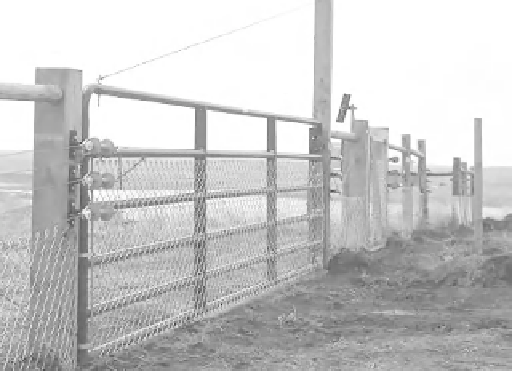Environmental Engineering Reference
In-Depth Information
ground elevation at the exit is 10.100 m, and the
flow depth at the outflow section is 0.500 m under
design conditions. Estimate the water elevation at
the inflow section.
8.2.
A sharp-crested weir located at the exit of a wetland
is to accommodate a design flow of 1.5 m
3
/s. The
weir is 40 cm high and 35 m long. If the down-
stream water surface is below the crest of the weir,
estimate the depth of water at the exit of the
wetland. By how much would this depth change if
the water surface downstream of the weir is 10 cm
above the crest of the weir?
8.3.
A constructed wetland is to treat 5000 m
3
/d of
wastewater with a 5-day BOD of 80 mg/L. The
average annual rainfall is 700 mm/year, the average
annual ET is 550 mm/year, of which 50% is transpi-
ration, and infiltration to groundwater within the
wetland is 300 mm/year. The average depth of
water within the wetland is expected to be 0.50 m,
the porosity of the wetland with this depth of water
is 0.95, and the average temperature of the water is
22°C. Experiments in the wetland show that the
background 5-day BOD can be estimated as
10 mg/L and the decay constant as 37 m/y. Estimate
the effluent concentration for a wetland area of
10 ha. What wetland area would be required to
meet a effluent standard of 30 mg/L for 5-day
BOD?
Figure 8.17.
Fence for wildlife exclusion.
Source
: U.S. Fish
and Wildlife Service (2005).
result in the removal of a large quantity of contami-
nants, such as nutrients, unless the plants are harvested
several times during the growing season. Drawdowns of
water levels in a wetland followed by burning is some-
times used to control the invasion of woody vegetation
if that invasion is considered undesirable. When con-
trolled burning of wetlands is used, the impact on wild-
life and the potential introduction of inorganic nutrients
to the water column from the ash and sediments should
be taken into account.
The water level in surface flow treatment wetlands is
the key to both water quality improvement and vegeta-
tion success. Wetlands constructed to treat municipal
wastewater typically have little control on the inflow
unless authorities have given permission to bypass the
wetland if needed, or if a wastewater storage lagoon is
built upstream of the wetland. Most constructed wet-
lands have an outflow control structure, such as a weir
or gate, that can control the depth in the wetland. Water
depths of about 30 cm (1 ft) are optimum for many
herbaceous macrophytes used in treatment wetlands.
High water levels favor the treatment of phosphorus
that is associated with sedimentation and similar pro-
cesses, while shallow water levels lead to closer proxim-
ity of sediments to overlying water, causing anaerobic
or near-anaerobic conditions in the aquatic system
during the growing season. Low water levels favor the
reduction of nitrate nitrogen through denitrification.
8.4.
A free water surface constructed wetland is to be
designed to reduce the TP concentration from
1 mg/L in the influent to 0.1 mg/L in the effluent.
The influent flow rate is 2700 L/min, ET is 900 mm/
yr, the transpiration fraction is 0.6, infiltration is
negligible, and rainfall is 1500 mm/yr. It is antici-
pated that the TP background concentration in the
wetland is 0.04 mg/L, the temperature of the water
is 20°C, the areal rate coefficient is 18 m/yr, and that
the wetland can be designed as a 1-tank system.
Determine the area of the wetland that is required.
8.5.
A polishing wetland is to be designed to reduce the
phosphorus (P) concentration in stored agricultural
runoff from 0.1 to 0.05 mg/L at a flow rate of
5000 m
3
/d and a temperature of 20°C. The slope of
the land where the wetland is to be located is 0.1%.
Local design guidelines require that the constructed
wetland have a minimum size of 2-4 ha/1000 m
3
/d,
a hydraulic loading of 2.5-5 cm/d, a maximum
water depth of 50 cm, a minimum aspect ratio of
2:1, a minimum residence time of 7.5 days, and a
maximum loading of 0.81 kg P/ha/d. Design the
dimensions of the required wetland and show that
all the design requirements are met.
PROBLEMS
8.1.
A constructed wetland with dense vegetation is
50 m wide, 150 m long, and has a design flow of
0.40 m
3
is The longitudinal slope is 0.05%, the

Search WWH ::

Custom Search